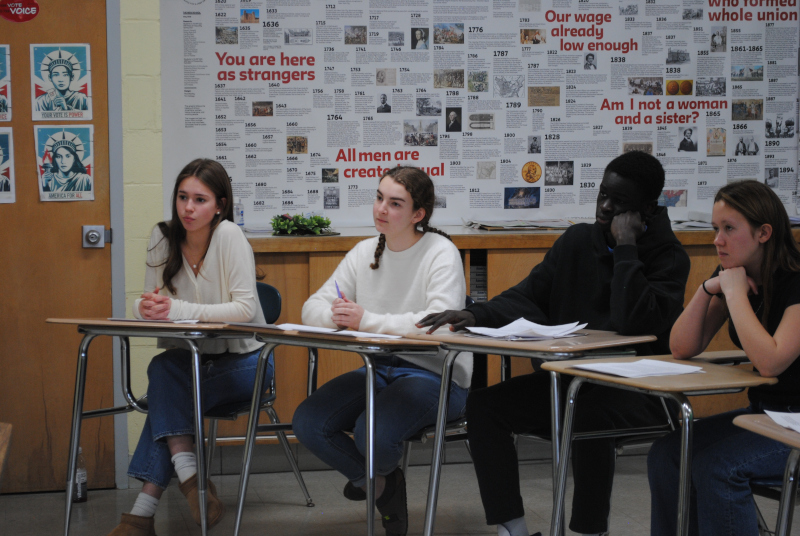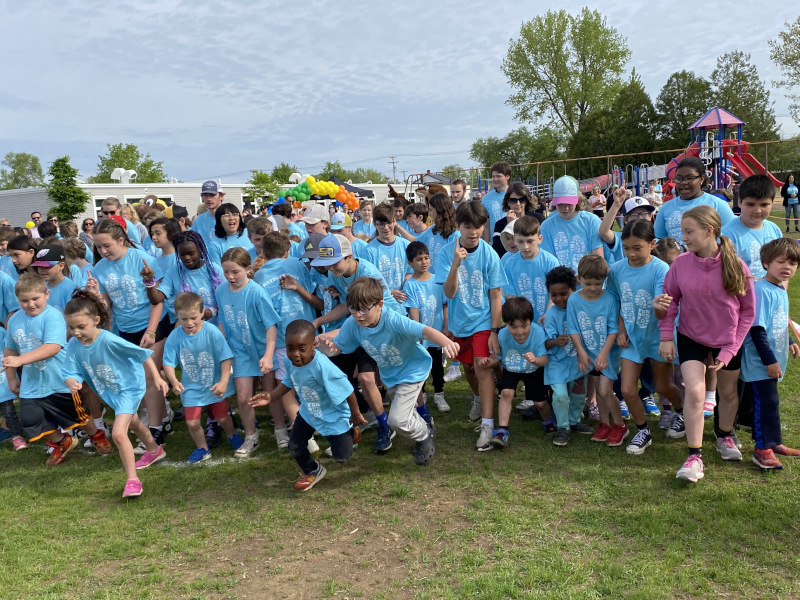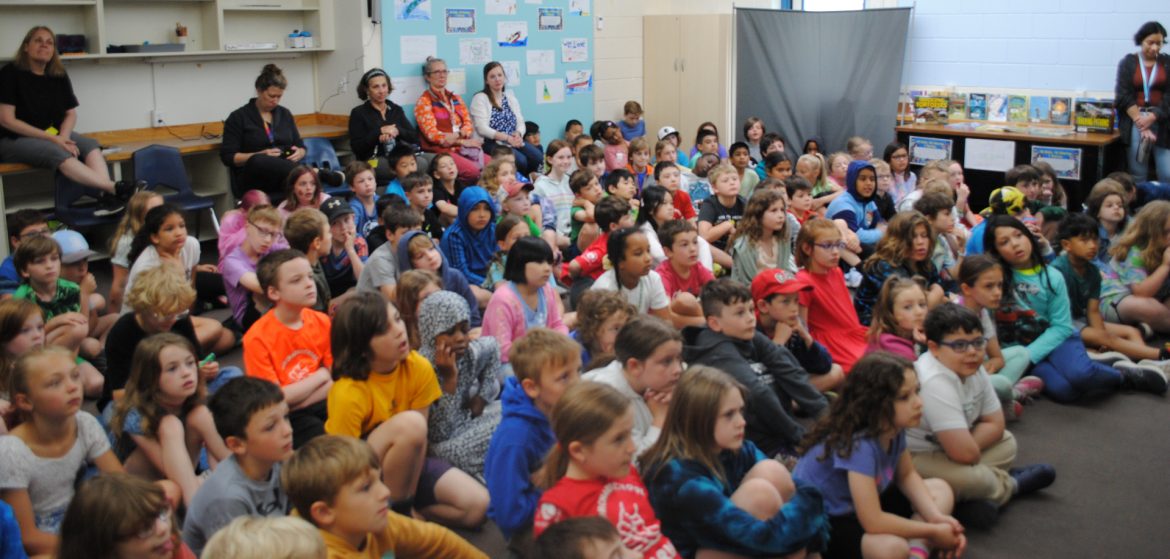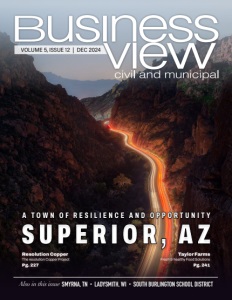The South Burlington School District
Increasing A focus on Social, Emotional Learning and Equity
A leading school district embraces innovation and excellence
Firmly committing to its holistic view of education has led the South Burlington School District to stunning educational successes. The district’s six campuses include Rick Marcotte Central Elementary School, Gertrude Chamberlin Elementary School, Orchard Elementary School, Frederick H. Tuttle Middle School,South Burlington High School and SouthPoint. and boasts a student population of 2,500 enrolled in grades Pre-K to 12. This leading district also employs 15 administrators and more than 600 teachers and staff.
“We pride ourselves in excellence and innovation,” says Violet Nichols, Superintendent of the SBSD, pointing to the District’s Ends policy which defines the intended outcomes, benefits, recipients, and costs of its methodology and practices. “The Ends policy is the goal for our students,” Nichols states. “It’s embedded in our policy and is part of our governance model. It’s a disposition for life-long learning, academic proficiency, personal development, and citizenship. All of our work to support students is directly tied to it.”
“We are moving to a focus on ‘excellence’ and ‘innovative’,” Nichols continues. “And we’re doing that through some pretty cutting-edge curricula developments and offering a broad variety of student-centered programming opportunities for students. We’re also making incremental gains in the development of social and emotional, cultural, and anti-racism learning. We are trying to develop a culture to support equity and anti-racism to best support our students and staff.”

Making Strides to Support students and staff
“With the increased social/emotional learning needs that we’ve been seeing off the back of the pandemic and the closure of therapeutic supports state-wide, we opened SouthPoint last year, and expanded it to cover the middle school, this year,” Nichols shares. (SouthPoint is an alternative therapeutic program that was created to take the place of Centerpoint, a regional program previously run through the Howard Center, Northeastern Family Institute, and Matrix Health systems that had ceased operations.) The District also participates in Project Search, which serves young people with significant intellectual and developmental disabilities. “It connects graduates with internships in the community,”
Nichols adds “It’s a special education initiative that bridges that time between high school and early adulthood and entrance into the community.” Like SouthPoint, we partner with neighboring districts to offer this program.
In the SBSD, working to better support teachers and staff is a goal of ours. Last year, the District implemented the Panorama Education Company’s survey platform for students as a way of assessing and screening them in areas of belonging, relationships and social and emotional well-being. Monica Desrochers, Director of Diversity, Inclusion, Anti-racism, and Emotional and Social Learning, reports that the District also issued a version of the survey to teachers, staff, and parents/guardians.
“The feedback indicated a desire for more explicit learning and conversations about race,” Desrochers notes. “Also, to better understand ourselves, our own power, our own privilege, and how that shows up in lesson planning and our curriculum design. This year, in pre-K through 12, all educators and people that work with our community, like our SRO (School Resource Officer), will be joining in on anti-racist learning and I think that the exciting thing about that is that we have teachers leading that work in a facilitation model. We’re growing this greenhouse of in-house people who feel comfortable holding these conversations and supporting our colleagues.”
The culture at SBSD clearly reveres self-examination and continual personal and professional growth. “In order to build and nurture life-long learners, we have to model that in ourselves,” Desrochers explains.
“That’s our approach to professional learning — to honor our own growth so that students can feel more comfortable on that scale, too. We have set a district goal in social/emotional learning and raising students’ sense of belonging. And that encompasses that idea that we are constantly evolving and we can be better people every day. We are striving to show that and to model life-long learning — not just in the typical way of math and science and ELA (English Language Arts), but also in human growth and being a contributor in this world.”
Pathways to learning
Jody Vaillancourt is SBSD’s Executive Director of Learning. She notes that the District offers students many flexible pathways for learning. On the high school level, there is the Big Picture Program, part of the national Big Picture Learning Network. It’s a project-based program that seeks to engage and motivate students through independent learning and student-driven curriculum. Students collaborate with teacher advisors to design their Personalized Learning Plan based on their goals, skills, and passions — learning through internships, independent projects, skill-building workshops, service learning and travel, traditional South Burlington High School classes, and dual enrollment in college courses.
“Our number-one goal is to support students, so student-centered decision making is critically important in everything that we do,” says Nichols.
Of course, as a first-class, 21st century school (in 2022, the school achieved the number two spot in the U.S. News and World Report Public School Rankings), South Burlington High School also provides many other offerings. There are three different career/technical education (CTE) programs (formerly known as Vo-Tech), as well as advanced mathematics and science programs that are available on a yearly basis. There’s band, chorus, and theater opportunities, and world language course work for students interested in expanding their cultural outlook and expertise.
“We have a multitude of digital design courses, and teachers are starting to use AI (Artificial Intelligence) to help with instruction and projects,” adds Nichols. We have 1:1 devices for grades 1-12, and we’re using technology support through our UDL (Universal Design for Learning), which is the framework through which we deliver all of our programming for our curriculum.”
“We just finished a project where we installed displays in all pre-K – 12 classrooms. We have voice amplification systems in all of our classrooms and we have high quality sound and display systems, which increases student accessibility to programming. We have Ipads for assisting students in communication; and a broad variety of cloud-based applications are in use.”
“Our students do have access to multiple AP courses, as well,” Vaillancourt adds.
“We have technology, art, and music classes that allow students to explore their passions and challenge themselves academically. And then we also have an educational and cultural exchange program between South Burlington High School and a school in Germany, It’s called TIE – The International Experience.”
Pathways to learning
Jody Vaillancourt is SBSD’s Executive Director of Learning. She notes that the District offers students many flexible pathways for learning. On the high school level, there is the Big Picture Program, part of the national Big Picture Learning Network. It’s a project-based program that seeks to engage and motivate students through independent learning and student-driven curriculum. Students collaborate with teacher advisors to design their Personalized Learning Plan based on their goals, skills, and passions — learning through internships, independent projects, skill-building workshops, service learning and travel, traditional South Burlington High School classes, and dual enrollment in college courses.
“Our number-one goal is to support students, so student-centered decision making is critically important in everything that we do,” says Nichols.
Of course, as a first-class, 21st century school (in 2022, the school achieved the number two spot in the U.S. News and World Report Public School Rankings), South Burlington High School also provides many other offerings. There are three different career/technical education (CTE) programs (formerly known as Vo-Tech), as well as advanced mathematics and science programs that are available on a yearly basis. There’s band, chorus, and theater opportunities, and world language course work for students interested in expanding their cultural outlook and expertise.
“We have a multitude of digital design courses, and teachers are starting to use AI (Artificial Intelligence) to help with instruction and projects,” adds Nichols. We have 1:1 devices for grades 1-12, and we’re using technology support through our UDL (Universal Design for Learning), which is the framework through which we deliver all of our programming for our curriculum.”
“We just finished a project where we installed displays in all pre-K – 12 classrooms. We have voice amplification systems in all of our classrooms and we have high quality sound and display systems, which increases student accessibility to programming. We have Ipads for assisting students in communication; and a broad variety of cloud-based applications are in use.”
“Our students do have access to multiple AP courses, as well,” Vaillancourt adds.
“We have technology, art, and music classes that allow students to explore their passions and challenge themselves academically. And then we also have an educational and cultural exchange program between South Burlington High School and a school in Germany, It’s called TIE – The International Experience.”
Teams and clubs
Nichols declares that the school is “an athletic powerhouse,” and that its co-curricular offerings are “incredibly vast.” Co-curricular offerings are important because they are designed to provide a broad variety of activities to engage as many students as we can.
“We have a Dungeons and Dragons Club; a Coalition for Community Service; a Ping-Pong Club; a Robotics Club; Bowling; and Unified Sports programs, which engages students with and without disabilities to promote sports, lifelong fitness, and recreational skills. And we have a Neuro-Science Club.” There are also clubs to help support teenagers in the areas of sexuality and inclusion – the queer/straight alliance and the gender/sexuality groups start in middle school and go through high school.
“That’s given students the opportunity to work with Outright Vermont (an organization focused on supporting LGBTQ+ youth and adults, including programs specifically for gender-creative kids and transgender individuals), attend conferences at the University of Vermont, visit the state house to lobby, and sponsor activities at the school to help parents become more comfortable with gender decisions that their students may be facing,” explains Tim Jarvis, SBSD’s Senior Director of Finance and Operations, who has two high-schooled-aged daughters. “We go way beyond the norm and tradition to ensure that our extra-curricular activities are inclusive for all our students.”

Infrastructure, Operations and capital projects
Maintaining the District’s buildings and infrastructure is Jarvis’s main responsibility, and he notes that many of SBSD’s capital investments are climate-friendly, as well. “We had an overcrowding situation at two of our elementary schools that demanded action,” he recounts. “So, we have constructed zero energy modulars (ZEMs), which are extremely efficient classrooms at those two schools. That was a major initiative that we had to address that aligned with our climate action goals. We have four electric buses in our fleet and we were one of the early adopters in Vermont for adding electric buses, partnering with Highland Electric Fleets on the implementation. We worked closely with Green Mountain Power and other entities to receive grants to fund them and we’ve just utilized a new EPA grant to add two more electric buses to our fleet.
“Working with many of our community partners, we’ve initiated a few other significant projects in the last year. One was adding heat pumps at two of our elementary schools. They had never had air conditioning and as the temperature started rising in August and September, we felt it was critical for them to have some efficient energy supply and air conditioning; we invested about a million dollars in that. We also invested about $600,000 on improving our HVAC controls through variable frequency drives. We’ve done lighting projects – replacing old fluorescent lights with LED lamps; and we’ve had some printer reduction initiatives working with our vendors for all our printers and copiers to cut down on the production of paper.”
Challenges ahead
Going forward, Nichols says the District will soon be confronting severe economic challenges.
“Given the significant restructuring of the State of Vermont’s education funding formula, we’re facing massive reductions in staffing and programming,” she reveals. “The money that we would get per pupil is being significantly diminished. So, we’re looking at a switch from robust programming that is best practice for supporting students in our community to providing what could look like bare bones. We have significant facility needs that we need to address at the middle and high school level and we’re in no position to bring a bond to our community, given the potential double-digit tax rates seen throughout the State that we could be facing. So, this is very much a crisis and it’s impacting the wonderful work that we know is best for supporting our students, our staff, and our community.
“Moving forward with far less is something that we’re going to have to get really creative on. I’m engaging in preliminary conversations with other school districts on how we can enter into BOCES (Board of Cooperative Education Services) agreements and how we can continue to maintain programming with significant reductions. So, it’s really a time in our District where we’ve never come across such a significant challenge. As a school community, we’re going to have to work really hard to determine what we’re prioritizing and how we’re going to move forward to support our students.”
And yet, Nichols is determined to stay positive.
“The South Burlington School District is an incredible place,” she states. “We’re one of the few districts in the state that is growing and we’re consistently ranked the number one district in the state. There are unique cultures at each school and this is a place where staff at all levels and positions want to be. We have a lot of heart here and a lot of soul.”
“I am honored to be the Superintendent who has the privilege of learning and working alongside our students, staff and community. Those are just two of the necessary attributes of a continuously evolving profession.”
AT A GLANCE
The South Burlington School District
WHAT: A Pre-K-12 school district with 2,500 students
WHERE: In South Burlington, Vermont
WEBSITE: www.sbschools.net



